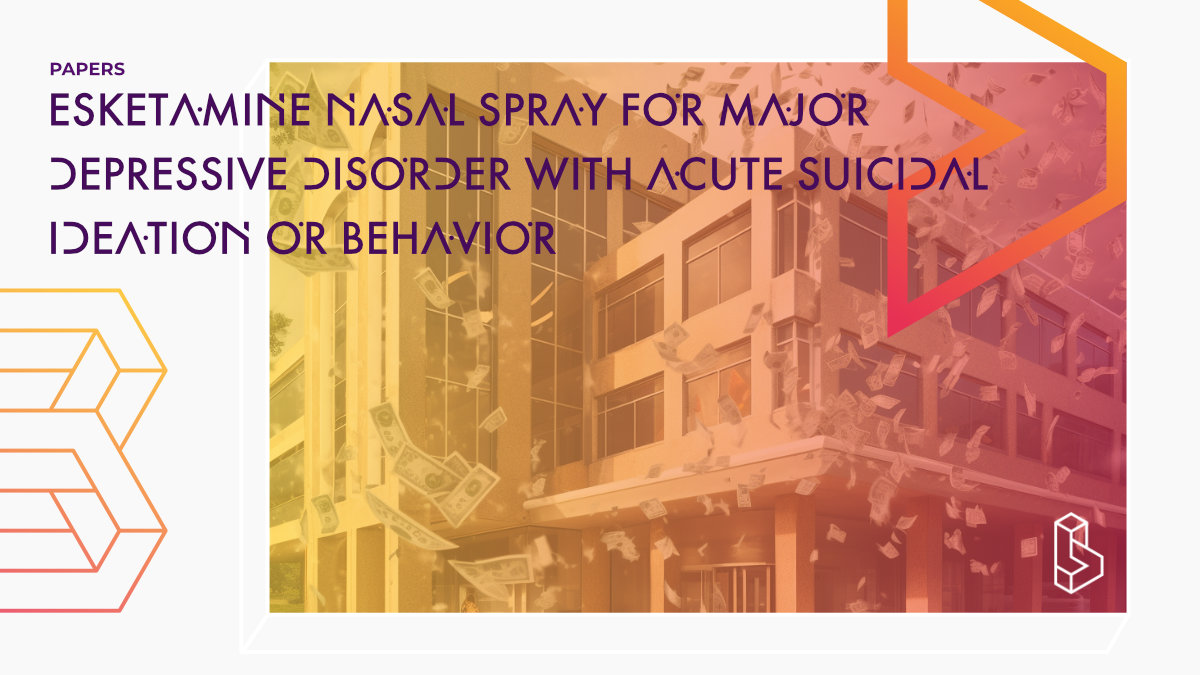This real-world (n=269) analysis of esketamine (Spravato) use finds nearly 50% of patients had their first pharmacy claim approved. Of those approved, 45% had eight or more treatment sessions (as recommended), though spread over 85 days (versus 28 per the label). Patients had lower health utilization, but this could be due to factors outside of the esketamine treatment (e.g. regression to the mean).
Abstract
“Aims To describe real-world esketamine nasal spray access and use as well as healthcare resource use (HRU) and costs among adults with evidence of major depressive disorder (MDD) with suicidal ideation or behavior (MDSI).
Methods Adults with ≥1 claim for esketamine nasal spray and evidence of MDSI 12 months before/on the date of esketamine initiation (index date) were selected from Clarivate’s Real World Data product (01/2016-03/2021). Patients initiated esketamine on/after 03/05/2019 (esketamine approval for treatment-resistant depression; later approved for MDSI on 08/05/2020) were included in the overall cohort. Esketamine access (measured as approved/abandoned/rejected claims) and use were described post-index; HRU and healthcare costs (2021 USD) were described over 6 months pre- and post-index.
Results Among 269 patients in the overall cohort with esketamine pharmacy claims, 46.8% had the first pharmacy claim approved, 38.7% had it rejected, and 14.5% abandoned their claim; 169 patients were initiated on esketamine in the overall cohort (mean age 40.9 years, 62.1% female); 45.0% had ≥8 esketamine treatment sessions (recommended per label) with a mean [median] of 85.0 [58.5] days from index to 8th session (per label 28 days). Among 115 patients with ≥6 months of data post-index, in the 6-month pre- and post-index, respectively, 37.4% and 19.1% had all-cause inpatient admissions, 42.6% and 33.9% had emergency department visits, 92.2% and 81.7% had outpatient visits; mean ± standard deviation all-cause monthly total healthcare costs were $8,371±$15,792 and $6,486±$7,614, respectively.
Limitations This was a descriptive claims-based analysis; no formal statistical comparisons were performed due to limited sample size as data covered up to 24 months of esketamine use in the US clinical setting.
Conclusions Nearly half of patients experience access issues with first esketamine nasal spray treatment session. All-cause HRU and healthcare costs trend lower in the 6 months after relative to 6 months before esketamine initiation.“
Authors: Maryia Zhdanava, Amanda Teeple, Dominic Pilon, Aditi Shah, Gabrielle Caron-Lapointe & Kruti Joshi
Summary of Esketamine nasal spray for major depressive disorder with acute suicidal ideation or behavior
Major depressive disorder (MDD) is a recurrent psychiatric condition that negatively affects patients’ lives. Suicidal ideation and behaviour can potentially be a devastating symptom of MDD, and patients with MDD are at increased risk for suicide. MDD with acute suicidal ideation or behaviour (MDSI) is associated with a substantial economic burden. Early identification and treatment of patients with MDSI may reduce the risk of suicidal ideation or Accepted Manuscript behaviour, preventing the subsequent financial burden.
Esketamine nasal spray is a novel therapy approved by the US Food and Drug Administration for treatment-resistant depression (TRD) and for MDSI, and has demonstrated rapid and significant reduction in depressive symptoms amongst patients with MDSI. In this study, patients with suicidal ideation or behaviour symptoms may have been initiated on esketamine nasal spray after approval for either indication. The study used Clarivate’s Real World Data product, an open claims database containing information on the prescription life cycle.
Find this paper
https://doi.org/10.1080/13696998.2023.2208993
Open Access | Google Scholar | Backup | 🕊
Study details
Compounds studied
Ketamine
Topics studied
Depression
Treatment-Resistant Depression
Suicidality
Economics
Study characteristics
Observational
Open-Label
Participants
269
Humans
Linked Research Papers
Notable research papers that build on or are influenced by this paper
Access and real-world use patterns of esketamine nasal spray among patients with treatment-resistant depression covered by private or public insuranceThis retrospective analysis (n=535) describes the access and real-world use patterns of esketamine nasal spray among adults with treatment-resistant depression (TRD). Of the pharmacy claims for esketamine, 34.6% were approved, 46.3% were rejected, and 19.1% were abandoned. The approval rate increased to 85.2% by the second treatment session. Among 273 patients who initiated esketamine (mean age 49.3 years; 66.3% female), the mean number of sessions was 11.8 over a mean of 11.8 months, with 47.6% completing at least 8 sessions, and 93.8% of those completing induction continuing treatment.

